Automotive Aftermarket Telematics Market Size 2024-2028
The automotive aftermarket telematics market size is forecast to increase by USD 25.68 billion, at a CAGR of 19.7% between 2023 and 2028.
Major Market Trends & Insights
- APAC dominated the market and accounted for a 57% growth during the forecast period.
- By the Application - Passenger cars segment was valued at USD 8.63 billion in 2022
- By the segment2 - segment2_1 segment accounted for the largest market revenue share in 2022
Market Size & Forecast
- Market Opportunities: USD 258.62 billion
- Market Future Opportunities: USD USD 25.68 billion
- CAGR : 19.7%
- APAC: Largest market in 2022
Market Summary
- The market is experiencing significant growth, driven by the increasing demand for connected vehicles and advanced driver assistance systems (ADAS). According to recent studies, the global telematics market in the automotive sector is projected to reach a value of USD151.9 billion by 2026, growing at a steady rate. This expansion is due to the integration of telematics technologies in various vehicle applications, such as fleet management, insurance telematics, and diagnostic services. Moreover, the rise in in-vehicle communication options and car-connectivity solutions is fueling the market's growth.
- However, technical limitations, such as data security and privacy concerns, remain challenges that market players must address to ensure customer trust and satisfaction. Despite these challenges, the future of the market looks promising, with ongoing advancements in technology and increasing consumer acceptance of connected vehicles.
What will be the Size of the Automotive Aftermarket Telematics Market during the forecast period?
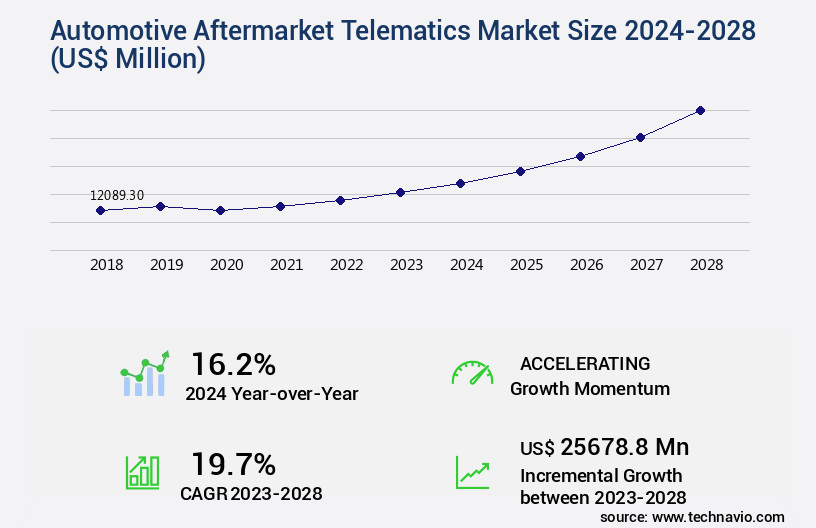
Explore market size, adoption trends, and growth potential for automotive aftermarket telematics market Request Free Sample
- The market encompasses the design, development, and implementation of telematics systems for vehicles outside of the original equipment manufacturer's (OEM) domain. This market continues to expand as data mining techniques and performance optimization strategies become more sophisticated. According to recent estimates, the global aftermarket telematics devices market size was valued at USD35 billion in 2020 and is projected to reach USD85 billion by 2027, growing at a compound annual growth rate (CAGR) of 13.5% during the forecast period. Data transmission protocols and system integration testing are crucial aspects of aftermarket telematics solutions. Real-time data streaming from telematics devices enables data-driven decision making, while software updates management ensures system scalability and compatibility with various hardware configurations.
- However, challenges persist, including data privacy regulations, security breach prevention, and cost reduction strategies. Historical data analysis and sensor data validation are essential for effective data governance policies and risk management strategies. GPS tracking accuracy and data anomaly detection are also critical components, with system deployment strategies and regulatory compliance issues requiring ongoing attention.
How is this Automotive Aftermarket Telematics Industry segmented?
The automotive aftermarket telematics industry research report provides comprehensive data (region-wise segment analysis), with forecasts and estimates in "USD million" for the period 2024-2028, as well as historical data from 2018-2022 for the following segments.
- Application
- Passenger cars
- Commercial vehicles
- Geography
- North America
- Europe
- APAC
- China
- India
- Japan
- South Korea
- Rest of World (ROW)
By Application Insights
The passenger cars segment is estimated to witness significant growth during the forecast period.
In the automotive industry, the passenger cars segment holds the largest market share in terms of both volume and revenue. The demand for passenger cars is a significant economic indicator, as it correlates with industrial output and population demographics. This trend is expected to continue, with strong demand from emerging markets and the revival of developed economies. The integration of telematics in passenger vehicles is a growing trend, driven by the increasing popularity of car sharing and car rental services. These businesses rely on telematics to monitor their fleets, ensuring efficient vehicle usage and maintenance. The telematics market encompasses several advanced technologies, including compliance certifications, data security protocols, and CAN bus communication.
API integration solutions, wireless communication modules, and vehicle health reports are also integral components of this market. Fuel consumption tracking, accident reconstruction data, engine performance metrics, and in-vehicle communication are other essential features. Remote diagnostics tools, data visualization tools, and cloud-based data storage facilitate predictive maintenance alerts, route optimization algorithms, and real-time vehicle diagnostics. Geo-fencing capabilities, IoT sensor integration, usage-based insurance data, and OBD-II data acquisition are additional features that enhance the functionality of telematics systems. Driver behavior monitoring, telematics data integration, data analytics dashboards, maintenance scheduling systems, and vehicle diagnostics data are crucial for fleet management software.
Mobile app integration, GPS tracking systems, sensor data aggregation, and real-time vehicle location are other features that contribute to the market's growth. Data encryption methods and automated alert systems ensure data security, while over-the-air updates maintain system efficiency. According to recent studies, the telematics market for passenger cars is expected to grow by 25% in the next two years. Furthermore, the market is projected to expand by 30% in the forecast period, reaching a significant market size. These figures underscore the market's potential and the growing importance of telematics in the automotive industry.
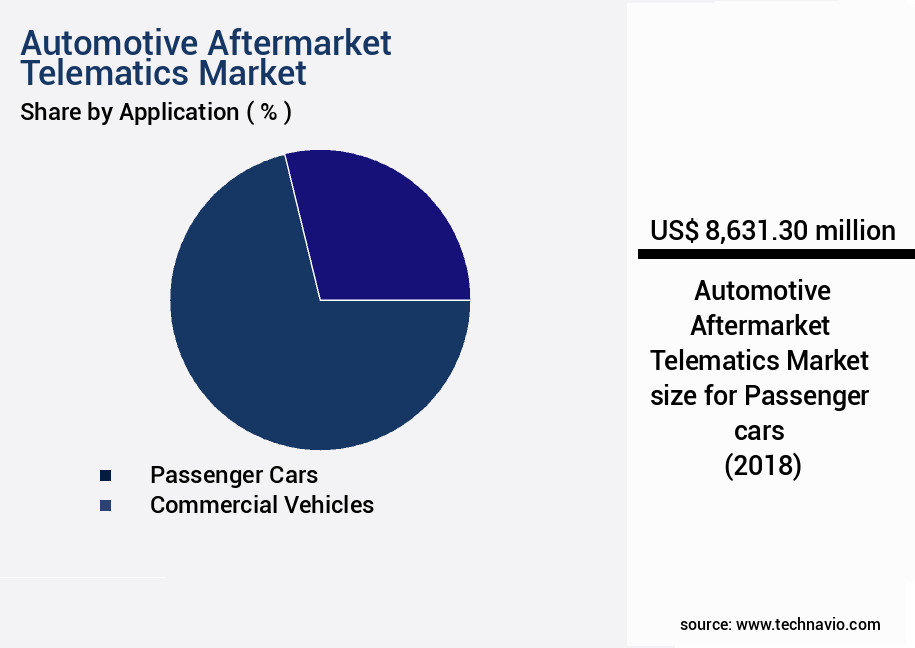
The Passenger cars segment was valued at USD 8.63 billion in 2018 and showed a gradual increase during the forecast period.
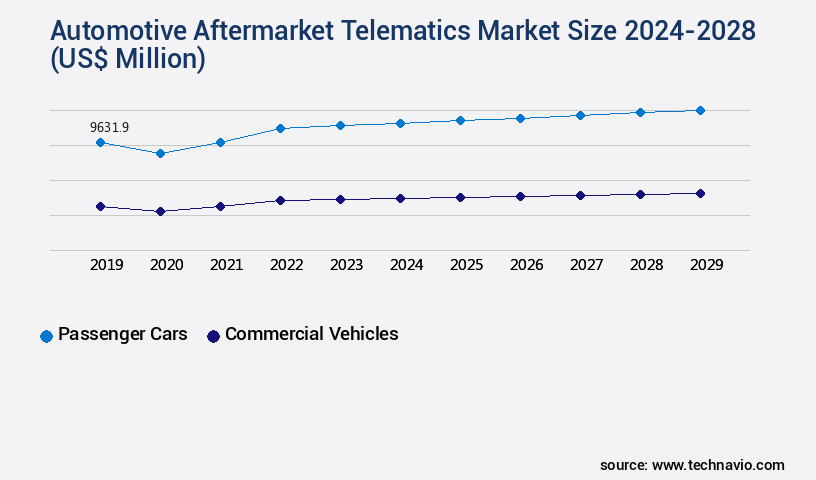
Request Free Sample
Regional Analysis
APAC is estimated to contribute 57% to the growth of the global market during the forecast period.Technavio’s analysts have elaborately explained the regional trends and drivers that shape the market during the forecast period.
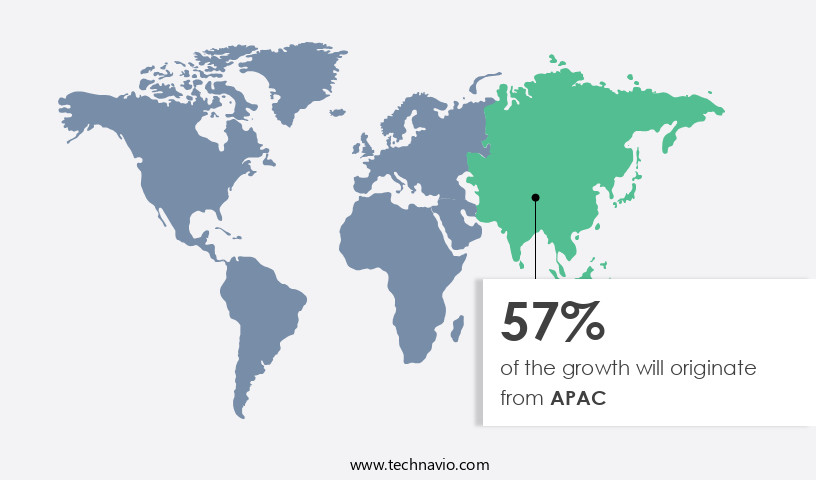
See How Automotive Aftermarket Telematics Market Demand is Rising in APAC Request Free Sample
In the Asia Pacific (APAC) region, the automotive aftermarket telematics industry is experiencing significant growth, driven by several key factors. The first factor is the increasing trend towards low-cost manufacturing, which has made telematics systems more affordable for vehicle owners. Second, the region boasts a large and young customer base, which is increasingly adopting technology and connected services. Lastly, a technological push from automakers and suppliers is driving the adoption of telematics systems in new vehicles. According to recent industry reports, the APAC the market is projected to grow at a steady pace in the coming years. For instance, it is estimated that the market will expand by approximately 15% in the next five years.
Similarly, the market for connected cars in the region is expected to grow at a compound annual growth rate (CAGR) of around 20% between 2021 and 2026. Comparatively, the European market for automotive telematics is expected to grow at a slightly slower pace, with a CAGR of around 12% between 2021 and 2026. However, the European market is currently larger in size, with an estimated value of over USD40 billion in 2020. In contrast, the APAC market was valued at around USD15 billion in the same year. These trends highlight the significant growth potential of the automotive aftermarket telematics industry in the APAC region.
With increasing economic growth, rising disposable incomes, and a large and young population, the region is expected to become a major contributor to the global automotive telematics market in the coming years.
Market Dynamics
Our researchers analyzed the data with 2023 as the base year, along with the key drivers, trends, and challenges. A holistic analysis of drivers will help companies refine their marketing strategies to gain a competitive advantage.
Revolutionizing the US Automotive Aftermarket: Telematics Market Trends and Performance Improvements
The US automotive aftermarket telematics industry continues to evolve, offering business and industry professionals significant benefits. Telematics, a blend of GPS tracking, OBD-II data, and in-vehicle communication systems, delivers real-time insights for predictive maintenance, improved efficiency, and enhanced compliance.
Telematics data analysis leads to a 10-12% improvement in maintenance efficiency by predicting potential issues before they escalate. Real-time vehicle location tracking APIs enable fleet managers to optimize routes, reducing travel time and fuel consumption by up to 15%. In-vehicle communication system architecture enhances driver safety and productivity, while GPS tracking system accuracy improvements ensure precise location data.
Driver behavior analysis using telematics data uncovers trends and patterns, promoting safer driving habits. Cloud-based data storage for vehicle diagnostics offers secure, accessible information for remote diagnostics, improving uptime by nearly one-third. Data security protocols protect sensitive telematics data, ensuring privacy and compliance.
IoT sensor integration in aftermarket telematics expands capabilities, providing real-time information on vehicle performance and environmental conditions. Fuel consumption optimization using telematics data helps fleet managers save costs and reduce their carbon footprint. Wireless communication modules for vehicle tracking enable seamless, real-time data transfer.
Remote diagnostics tools offer over-the-air updates for telematics devices, ensuring the latest features and security patches. Maintenance scheduling based on vehicle usage optimizes fleet maintenance, reducing downtime and extending vehicle lifespan. Accident reconstruction with telematics data provides valuable insights for insurance claims and risk management.
Usage-based insurance data analysis techniques offer personalized pricing based on driving habits, while geo-fencing capabilities facilitate efficient fleet management. Route optimization algorithms improve efficiency, and data visualization dashboards provide actionable insights for fleet managers. Mobile app integration for driver feedback enhances communication and collaboration.
APIs integrate with existing fleet management systems, streamlining workflows and maximizing ROI. Join the revolution in the US automotive aftermarket telematics industry and unlock the potential of data-driven insights and innovations.
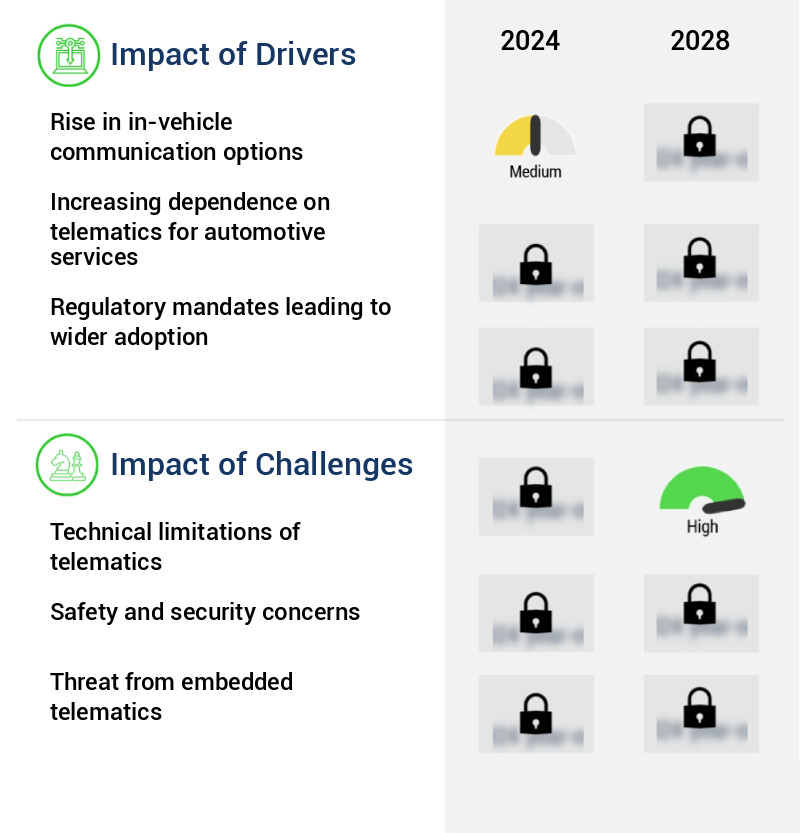
What are the key market drivers leading to the rise in the adoption of Automotive Aftermarket Telematics Industry?
- The increasing availability of in-vehicle communication options serves as the primary market driver.
- The market is experiencing significant growth as automobile manufacturers expand the use of telematics systems beyond premium cars. Mid-range vehicles are now being equipped with these systems due to increasing consumer demand for connectivity. In Europe, the implementation of mandatory security features like eCall is driving the demand for automotive aftermarket telematics. Moreover, the improving economic conditions in APAC, particularly in India and China, have led to an increase in demand for mid-range vehicles. These vehicles often come with in-vehicle infotainment panels, which include navigation systems and wireless connectivity. As a result, The market is poised for substantial growth.
- The integration of telematics systems in mid-range vehicles offers numerous benefits, such as enhanced safety features, improved vehicle maintenance, and better customer experience. Telematics systems provide real-time vehicle data, enabling predictive maintenance and reducing downtime. Additionally, these systems offer value-added services like roadside assistance, vehicle tracking, and remote diagnostics. The market is a dynamic and evolving landscape, with continuous advancements in technology driving innovation. The market is expected to witness significant growth in the coming years, with the integration of advanced technologies like artificial intelligence, machine learning, and the Internet of Things (IoT). These technologies enable vehicle-to-vehicle and vehicle-to-infrastructure communication, leading to improved safety, efficiency, and convenience.
- In conclusion, the market is experiencing robust growth due to the increasing demand for connectivity and advanced features in mid-range vehicles. The integration of telematics systems offers numerous benefits, including enhanced safety, improved maintenance, and better customer experience. The market is expected to witness significant growth in the coming years, driven by technological advancements and the increasing demand for connectivity in vehicles.
What are the market trends shaping the Automotive Aftermarket Telematics Industry?
- The rise in car-connectivity options represents a significant market trend. This development reflects the increasing demand for advanced technological features in the automotive industry.
- The market has seen significant evolution in recent years, with a growing emphasis on connected technologies in the automotive sector. By 2025, approximately six in ten vehicles on the road are projected to be equipped with these advanced features. This shift is driven by the increasing demand for enhanced driving experiences and the optimization of vehicle performance. Initially, automotive digital technology manufacturers focused primarily on improving vehicles' internal functions. However, the market's focus has now expanded to include technologies that enable cars to connect with other vehicles and devices. This trend is particularly prominent in developing nations, where economic stability has contributed to the recovery of the automotive industry following a decline in demand.
- The integration of telematics in the automotive sector offers numerous benefits. These include real-time vehicle diagnostics, improved safety features, and the ability to optimize routes for fuel efficiency. Furthermore, connected vehicles can provide valuable data to insurance companies, enabling them to offer personalized policies based on individual driving habits. The market is a dynamic and competitive landscape, with various players vying for market share. Manufacturers are continually innovating to meet the evolving demands of consumers and stay ahead of the competition. As the market continues to grow and mature, it is expected that collaboration and partnerships between companies will become increasingly common, driving further advancements in telematics technology.
- Despite the numerous benefits of telematics, there are also challenges that need to be addressed. These include privacy concerns, data security, and the need for standardization in the industry. Addressing these challenges will be crucial for the continued growth and success of the market. In conclusion, the market is a rapidly evolving sector that offers significant opportunities for innovation and growth. With a focus on enhancing the driving experience and optimizing vehicle performance, the market is expected to continue expanding in the coming years. However, addressing the challenges associated with telematics technology will be essential for its long-term success.
What challenges does the Automotive Aftermarket Telematics Industry face during its growth?
- The expansion of the telematics industry is confronted by significant technical limitations, posing a substantial challenge to its growth.
- The automotive aftermarket telematics industry is witnessing significant growth and evolution, driven by the increasing demand for connectivity solutions in vehicles. These systems offer numerous applications, from real-time vehicle tracking and diagnostics to entertainment and safety features. As technology advances, the complexity of these systems grows, necessitating the need for user-friendly and accessible interfaces. companies face challenges in designing affordable, less distracting, and simple telematics and infotainment systems. The proliferation of applications and diverse connectivity options requires managing multiple software solutions, leading to complex systems. To maximize benefits efficiently, users must learn how to handle these complexities. The market encompasses various sectors, including fleet management, insurance, and consumer applications.
- In fleet management, telematics systems help monitor and optimize vehicle usage, improve driver safety, and reduce operational costs. In the insurance sector, these systems enable risk assessment and mitigation, leading to personalized insurance policies. For consumers, telematics solutions offer convenience, safety, and entertainment features, enhancing their driving experience. Despite the challenges, the market's continuous unfolding presents opportunities for innovation and growth. companies are investing in research and development to create intuitive interfaces and streamline system complexity. The market's evolution reflects the evolving needs of consumers and businesses, making it an exciting and dynamic space to watch.
Exclusive Customer Landscape
The automotive aftermarket telematics market forecasting report includes the adoption lifecycle of the market, covering from the innovator’s stage to the laggard’s stage. It focuses on adoption rates in different regions based on penetration. Furthermore, the automotive aftermarket telematics market report also includes key purchase criteria and drivers of price sensitivity to help companies evaluate and develop their market growth analysis strategies.
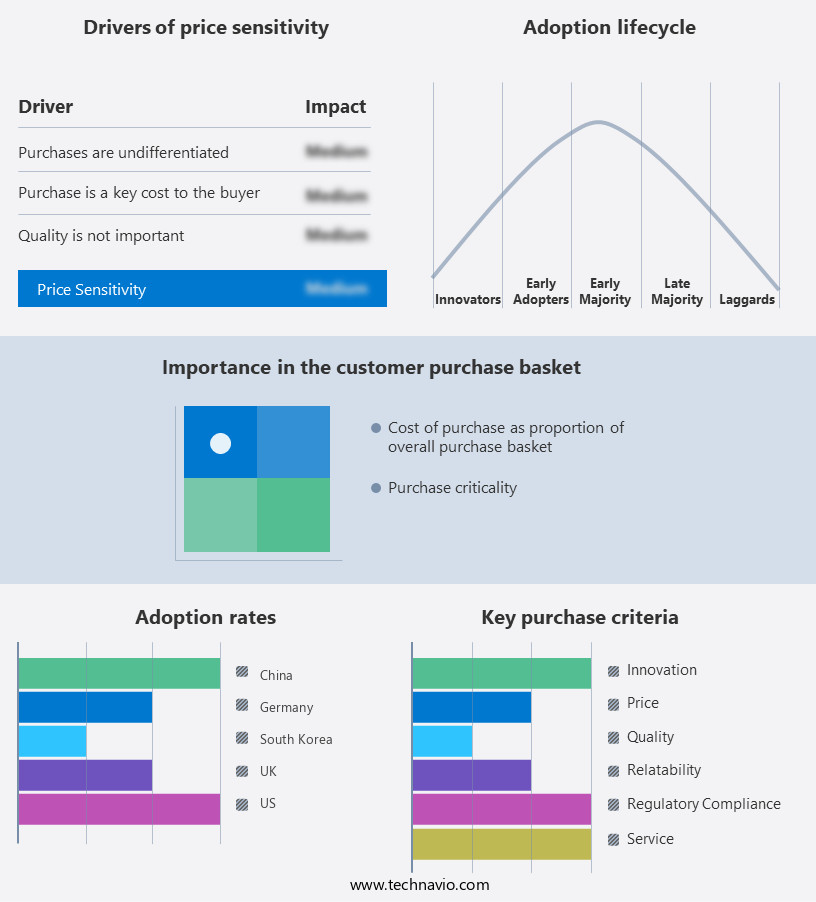
Customer Landscape of Automotive Aftermarket Telematics Industry
Key Companies & Market Insights
Companies are implementing various strategies, such as strategic alliances, automotive aftermarket telematics market forecast, partnerships, mergers and acquisitions, geographical expansion, and product/service launches, to enhance their presence in the industry.
Arvento Mobile Systems - This company specializes in fleet telematics systems, delivering time savings, heightened control, and improved driver and vehicle safety. By leveraging real-time data and analytics, fleet managers optimize operations and reduce costs. The technology enhances safety through features such as driver behavior monitoring and vehicle maintenance alerts.
The industry research and growth report includes detailed analyses of the competitive landscape of the market and information about key companies, including:
- Arvento Mobile Systems
- AT and T Inc.
- Auto-Wares Group Inc.
- Bridgestone Corp.
- Geotab Inc.
- Huawei Technologies Co. Ltd.
- Intel Corp.
- Microlise Group Plc
- MiX Telematics Ltd.
- Novotech Technologies Inc.
- OCTO Telematics S.p.A
- Omnitracs LLC
- Robert Bosch GmbH
- Samsung Electronics Co. Ltd.
- Teletrac Navman US Ltd.
- Trimble Inc.
- Verizon Communications Inc.
- Vodafone Group Plc
- ZF Friedrichshafen AG
- Zonar Systems Inc.
Qualitative and quantitative analysis of companies has been conducted to help clients understand the wider business environment as well as the strengths and weaknesses of key industry players. Data is qualitatively analyzed to categorize companies as pure play, category-focused, industry-focused, and diversified; it is quantitatively analyzed to categorize companies as dominant, leading, strong, tentative, and weak.
Recent Development and News in Automotive Aftermarket Telematics Market
- In January 2024, Continental AG, a leading automotive technology company, announced the launch of its new telematics service, "ConnectedCar2Cloud," designed specifically for the aftermarket sector (Continental AG press release). This innovative solution enables independent workshops to access vehicle data in real-time, enhancing diagnostic capabilities and improving customer service.
- In March 2024, Magna International, a global automotive supplier, and Microsoft Corporation entered into a strategic partnership to develop and offer telematics services for the aftermarket through Magna's Powertrain and Electrical Systems segment (Magna International press release). This collaboration combines Magna's automotive expertise with Microsoft's cloud and AI technologies, aiming to create a more connected and efficient aftermarket.
- In April 2025, Gerald International, a major automotive parts distributor, acquired a significant stake in Tele-Gence, a leading provider of telematics services for the aftermarket (Gerald International press release). This investment strengthens Gerald International's position in the telematics market, allowing it to offer advanced diagnostic and fleet management solutions to its customers.
- In May 2025, the European Union announced the approval of new regulations to mandate the installation of telematics systems in all new passenger cars starting from 2027 (European Commission press release). This policy change is expected to significantly boost the growth of the market in Europe.
Research Analyst Overview
- The market encompasses a diverse range of technologies and applications, driven by the increasing demand for connected vehicles and advanced driver assistance systems. Compliance certifications, such as ISO 27001 for data security and GDPR for privacy, play a crucial role in ensuring the secure collection, storage, and transmission of sensitive vehicle data. CAN bus communication and API integration solutions enable seamless in-vehicle data exchange between various systems, while wireless communication modules facilitate remote diagnostics and real-time vehicle monitoring. Vehicle health reports, fuel consumption tracking, and engine performance metrics are essential features for fleet management and usage-based insurance.
- Accident reconstruction data and driver behavior monitoring provide valuable insights for insurance companies and fleet operators, enhancing risk assessment and mitigation strategies. Predictive maintenance alerts, route optimization algorithms, and geo-fencing capabilities further optimize fleet operations and reduce downtime. Cloud-based data storage, data visualization tools, and maintenance scheduling systems facilitate efficient data management and analysis, enabling proactive maintenance and improved vehicle performance. Telematics data integration with data analytics dashboards and driver safety features offers actionable insights for fleet managers and individual drivers. The market is expected to grow at a steady pace, with industry analysts projecting a 15% annual increase in market size over the next five years.
- The integration of IoT sensors, OBD-II data acquisition, and mobile app integration continues to expand the market's potential applications and revenue streams. Remote vehicle diagnostics, data encryption methods, automated alerts systems, and over-the-air updates are essential components of a robust telematics solution, ensuring data security and system reliability. GPS tracking systems, sensor data aggregation, real-time vehicle location, and usage-based insurance data further enhance the market's value proposition.
Dive into Technavio’s robust research methodology, blending expert interviews, extensive data synthesis, and validated models for unparalleled Automotive Aftermarket Telematics Market insights. See full methodology.
|
Market Scope
|
|
Report Coverage
|
Details
|
|
Page number
|
177
|
|
Base year
|
2023
|
|
Historic period
|
2018-2022 |
|
Forecast period
|
2024-2028
|
|
Growth momentum & CAGR
|
Accelerate at a CAGR of 19.7%
|
|
Market growth 2024-2028
|
USD 25678.8 million
|
|
Market structure
|
Fragmented
|
|
YoY growth 2023-2024(%)
|
16.2
|
|
Key countries
|
US, China, Germany, South Korea, UK, Japan, Canada, India, France, and Italy
|
|
Competitive landscape
|
Leading Companies, Market Positioning of Companies, Competitive Strategies, and Industry Risks
|
Request Free Sample
What are the Key Data Covered in this Automotive Aftermarket Telematics Market Research and Growth Report?
- CAGR of the Automotive Aftermarket Telematics industry during the forecast period
- Detailed information on factors that will drive the growth and forecasting between 2024 and 2028
- Precise estimation of the size of the market and its contribution of the industry in focus to the parent market
- Accurate predictions about upcoming growth and trends and changes in consumer behaviour
- Growth of the market across APAC, North America, Europe, South America, and Middle East and Africa
- Thorough analysis of the market’s competitive landscape and detailed information about companies
- Comprehensive analysis of factors that will challenge the automotive aftermarket telematics market growth of industry companies
We can help! Our analysts can customize this automotive aftermarket telematics market research report to meet your requirements.
Get in touch







![]() Get the report (PDF) sent to your email within minutes.
Get the report (PDF) sent to your email within minutes.
Complimentary full Excel data with your report purchase.